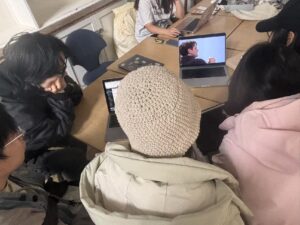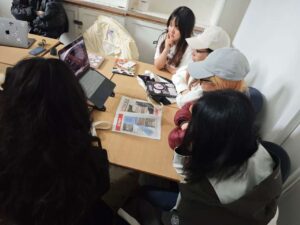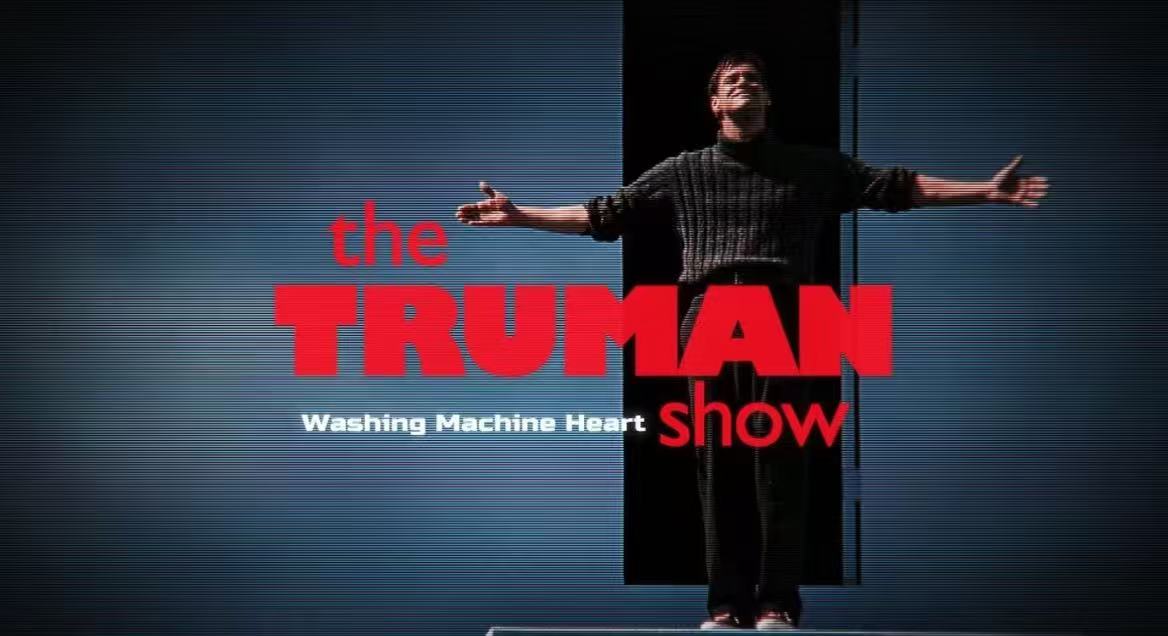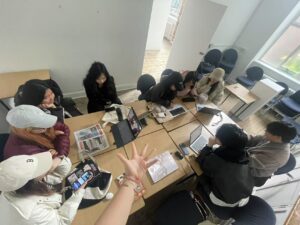This week’s event for our Collective is The Theater of Reality in Contemporary Art.
Here’s how it’s going to go:
10 min Introduction Briefly introduce the theme of Sleepwalker, the background of the film and the goal of the day: we are not watching a film, but rather observing ‘who is manipulating the reality of this film?
110 min Group viewing: ‘The Truman Show’ Focus on the film and take notes as you watch it
5 min Break & organisation of feelings Free time for rest/reflection
20 min Group discussion (two groups)
– Group A: Analysis of the way reality is constructed in terms of the film’s internal structure (lighting, dialogue, scene changes).
– Group B: Analysis of the audience’s point of view: ‘Why do we believe that this is real?’.
10 min Plenary debriefing + leading questions e.g. ‘Is Truman free?’ ‘Have you ever been in a ‘Truman state’?’ ‘What is the difference between us now and Truman?’
10 min Write down a key word Each person writes down a key word that he or she has felt today, such as ‘presupposition,’ ‘surveillance,’ ‘choice,’ ‘perception,’ etc., and post it on a sticker. Each person writes a key word that they have felt today, e.g. ‘presupposition’, ‘monitoring’, ‘choice’, ‘perception’, ‘cage’, etc., and puts it on the wall/uploads it on the Miro board
OPTIONAL Extension Session Watch a short film clip from Black Mirror, Westworld or the work of artists Omer Fast / Hito Steyerl to make cross-media connections.
I was in Group B, analysing ‘Why do we believe it’s true’ from the viewer’s point of view.
My understanding was:
1. The hypnotic nature of the media contract
The audience’s obsession with The Truman Show stems from a coded viewing contract: the promise of ‘authenticity’ of the 24-hour live camera broadcast and the myth of ‘transparency’ of no editing are essentially The ‘objectivity’ of the technological medium is essentially a fiction in disguise. This contract is synonymous with contemporary social media broadcasting culture – we believe that the mobile phone camera is the ‘window to the truth’, but we selectively ignore algorithmic filtering, beauty filters and traffic manipulation.
2. The Ethical Immunity of Voyeurism
When viewers gaze at Truman’s private life through the screen, they are granted a technologically mediated ethical exemption: the camera becomes a ‘dehumanising’ voyeuristic tool, shifting ethical responsibility to the media system. This is consistent with the psychological mechanism of Shakeology’s users when they watch the live broadcasts of the vegetarians – we believe that watching through the screen does not constitute real harm, but we do not realise that we are already the nerve endings of the system of oppression.
3. The violent production of realism
By controlling the weather, inserting actors, and creating unforeseen events, producer Kristof builds a world that is more ‘perfect’ than reality. The audience believes in this hyper-reality because it fulfils our projection of an ‘ideal life’ – Truman’s suffering is dramatised, his conflict is paced, and it is essentially a technologically concocted hallucinogen. The audience’s self-objectification.
4. Self-objectification of the audience
As the audience in the bar cheers Truman’s awakening, they briefly realise that they too are being watched (the television cameras are recording their reactions). This infinite reflection of the chain of viewing reveals a contemporary existential dilemma: we are both viewers of Truman and protagonists of the social media Truman Show, actively transforming our own lives into consumable data landscapes while consuming the reality of others.
So the key phrase I have summarised is that we are all lambs to the technical shepherds.
When Truman finally made his way to the exit of the ‘real world’, the audience was dismayed – they had lost not only a programme, but also a mirror image of their own cognitive order. This is a metaphor for the collective dilemma of humanity in the digital age: the more we rely on technological media to define the real, the more we are reduced to digital livestock in an algorithmic pasture.
When Tiktok adjusts the recommended content according to the zoom of your pupils, and when Meta uses brain-computer interfaces to directly stimulate the pleasure centre, the studio of the Truman Show has long been upgraded to a neural matrix wrapping the world. The ‘free choice’ that the audience thinks it has is just a cognitive fence preset by the technical shepherd.

Group A

Group B
Reflection:
The exploration of The Truman Show within the context of contemporary art underscores the intricate relationship between reality, perception, and media manipulation. This analysis reveals how constructed realities, much like those in the film, are prevalent in today’s media landscape, where authenticity is often simulated.journals.gen.tr
This phenomenon aligns with Baudrillard’s (1981) concept of hyperreality, where representations of reality become more real than reality itself, leading to a blurring of the lines between the real and the simulated. In the context of The Truman Show, the audience’s belief in Truman’s world exemplifies this hyperreal condition.
Moreover, the ethical implications of voyeurism in media consumption are evident. As Sontag (1977) discusses, the act of observing through a lens can desensitize viewers, creating a sense of detachment from the subject’s reality. This detachment is mirrored in the audience’s consumption of Truman’s life, raising questions about the morality of such engagement.
The self-objectification of audiences, as they become both consumers and participants in media narratives, reflects Debord’s (1967) notion of the spectacle, where social relationships are mediated by images. This dual role challenges the boundaries between observer and observed, suggesting a cyclical entrapment within media systems.
In conclusion, the analysis of The Truman Show within contemporary art discourse highlights the pervasive influence of media in shaping perceptions of reality. It calls for a critical examination of our roles as both creators and consumers within these constructed narratives.
Reference list
Baudrillard, J. (1981). Simulacra and Simulation. Ann Arbor, Mich.: University of Michigan Press.
Debord, G. (1967). The Society of the Spectacle. Detroit, Michigan: Black & Red.
Sontag, S. (1977). On Photography. New York: Farrar, Straus and Giroux.








Shiming Wang’s peer review :The curatorial project focuses on the relationship between clothing and female identity, presenting a detailed review of how the female body has been regulated, coded and expressed in Chinese history. The exhibition is clearly structured, especially within the conceptual framework of the “second skin”, which understands clothing as a means of political intervention that is both intimate and external. Through chapter Settings such as “Ritual Network” and “Power texture”, it effectively presents how clothing operates as a disciplining tool. As written in the article, “clothing becomes a visible boundary, constructed by tradition, morality and authority”, This precisely echoes the theory of “taming the body” put forward by Foucault (1977).
Although the project has a solid foundation in the historical dimension, there is still room for expansion in the connection with contemporary art practice. Tate Britain’s exhibition Women in Revolt! (2023) Through clothing, protest banners and archival images, feminist history is transformed into an “activation device” in the space, which not only shows the meaning of clothing, but also focuses on what it can “do” in the exhibition site (Tate Britain, 2023). This suggests that curatorial exhibition should not stop at reproduction, but should think about how clothing can intervene in reality with the action of things.
The choice of artists fits the overall theme. For example, Lin Tianmiao’s Protruding Patterns (2004) explores the shaping of femininity through yarn, text, and bodily fragments, offering strong material expressivity. More experimental, media-based practices could further enrich the narrative—such as Amy Karle’s Regenerative Reliquary (2016), which uses bioprinting to construct “regenerative bones,” pushing the “second skin” concept toward biotechnological imaginaries. As Karle noted, “the future body is not worn, but grown” (Karle, 2016)—a concept that strongly informs the section “Wearing the Future.”
In terms of theory, the project quotes Butler’s (1990) gender performance theory to provide a clear framework for the narrative, and proposes to further introduce Rosalind Gill’s (2007) critical perspective on “self-examination” and “aesthetic labor” in post-feminist media culture. It extends clothing from identity expression to “body work in a consumer society”. In addition, your proposed “dressing room as archive space” has potential relevance to the Domestic Bliss (GoMA, Glasgow) exhibition’s treatment of the “politicization of domestic space”, which can be translated into a multi-sensory exhibition mechanism – making clothes not only “seen”, but also heard, touched and even “worn memory”.
Questions worth exploring include: Do digital clothing and AR fitting constitute a new type of body monitoring? Can the historical archives of women’s clothing be curated as “counter-archives of interrupted time”? In an age of image overload, does how we dress also constitute a political gesture?
References:
Butler, J. (1990). Gender trouble: Feminism and the subversion of identity. Routledge.
Foucault, M. (1977). Discipline and punish: The birth of the prison (A. Sheridan, Trans.). Vintage Books.
Gill, R. (2007). Gender and the media. Polity Press.
Karle, A. (2016). Regenerative Reliquary [Bio-art installation]. Ars Electronica Festival.
Tate Britain. (2023). Women in Revolt! Art and Activism in the UK 1970–1990. Tate Publishing.
GoMA. (2019). Domestic Bliss. Gallery of Modern Art, Glasgow.